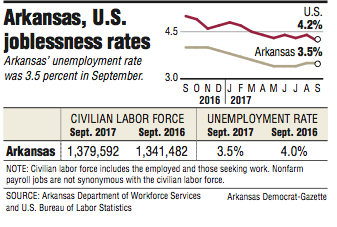Arkansas' unemployment rate was unchanged in September at 3.5 percent, the U.S. Bureau of Labor Statistics said Friday.
The national unemployment rate was 4.2 percent in September.
The state's unemployment rate is the second lowest since the unemployment rate has been calculated, going back to the 1960s. The lowest rate, 3.4 percent, was reported in May, June and July this year.
Arkansas' unemployment rate was the 12th lowest in the country.
It was a very positive report for the state, said Michael Pakko, chief economist at the Arkansas Economic Development Institute at the University of Arkansas at Little Rock. There were gains in employment, Pakko noted.
The only possible negative side to the report was the second consecutive monthly increase in unemployment, he said.
"Even with that, the labor force is growing fast enough to keep the unemployment rate fairly constant at 3.5 percent," Pakko said. "You can think about it as the very low rate of unemployment is drawing more people into the labor force."
The number of employed Arkansans grew by 43,387 in the past 12 months. There were 5,277 fewer unemployed Arkansans since September 2016. And the labor force grew by about 38,100.
Inevitably, the new people joining the labor force will go through periods of unemployment, Pakko said.
"We'll see the absolute numbers creeping up, but that shouldn't be seen as necessarily a bad sign," Pakko said.
With the unemployment rate so low, it's not easy to find candidates who qualify for jobs, said Stephanie Shine, director of permanent placement services for Robert Half Finance and Accounting in Little Rock.
This is one of the busiest times of the year, Shine said.
Shine leads a team that recruits job seekers in finance and accounting, from bookkeepers and staff accountants to controllers and chief financial officers. The company also recruits temporary and clerical workers in accounting and finance.
"Not only my division but also the temporary business is booming because seasonal help is starting to ramp up," Shine said.
Shine's office has seen double-digit growth since last year, she said.
"That is due to how the market has tightened up, and it is so extremely competitive to find top talent," Shine said. "Top talent is in demand and there are less candidates with that talent. Candidates are getting multiple offers, counteroffers and they are really diving deep into the offers. It could come down to the benefits or the vacation or the flexibility. It's not just about the compensation and the bonus anymore."
There was nothing in the unemployment report that was of concern, said Mervin Jebaraj, interim director of the Center for Business and Economic Research at the University of Arkansas, Fayetteville.
"And looking at what sectors are doing well makes [the report] even better," Jebaraj said.
Among the sectors that did well are the professional and business services sector, the educational and health services sector and the "other services" sector, Jebaraj said.
The educational and health services sector added 5,300 jobs since last September. The professional and business services sector grew by 4,700 jobs in the past 12 months, as did manufacturing. "Other services" added 2,300 jobs for the year.
Overall, there were gains in jobs over the past year in seven industry sectors, declines in four sectors and one that was unchanged.
The professional, scientific and technical services, a category of the professional and business services sector, saw a jump of 2,000 jobs in the past year, said Greg Kaza, executive director of the Arkansas Policy Foundation in Little Rock.
Components of the category include high-paying jobs such as computer systems design, management and technical consulting, and scientific research and development, Kaza said. On average, those jobs pay between $61,000 and $81,000 a year, Kaza said.
The success of the professional and business services sector is an indicator of the health of the overall economy in the state, Jebaraj said.
"You're talking about engineers and architects and accountants and lawyers," Jebaraj said.
Those occupations are needed when other areas of the economy are doing well, Jebaraj said.
"They process a lot of business services or build new buildings," Jebaraj said. "That to me is more indicative of sustainable growth instead of something like real estate or financial activities growing and driving the economy."
As long as the national economy keeps growing, it's possible that Arkansas' unemployment rate can remain low, Jebaraj said.
The country is in the 101st month of economic expansion and is only four or five months from having the second longest recovery in recorded history, Jebaraj said. The longest expansion was during the 1990s and the second longest was in the 1960s, Jebaraj said.
North Dakota had the lowest unemployment rate in the country at 2.4 percent, followed by Colorado and Hawaii at 2.5 percent each, New Hampshire at 2.7 percent and Idaho and Nebraska at 2.8 percent each.
Alaska had the highest rate at 7.2 percent, followed by New Mexico at 6.2 percent, Ohio at 5.3 percent, and Kentucky and Mississippi at 5.2 percent each.
Business on 10/21/2017
